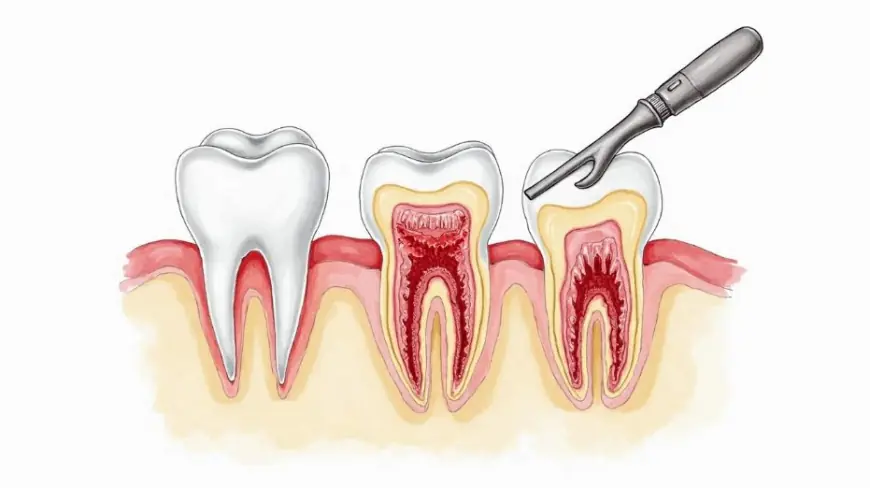How to Know If You Need Root Canal Therapy
Root canal therapy is a valuable procedure that can save a tooth from extraction and relieve significant pain caused by pulp infection or damage. Recognizing the signs and symptoms early, seeking prompt dental care, and maintaining good oral health are key to avoiding complications and preserving your natural teeth.


Root canal therapy is a common dental procedure that often sparks anxiety and questions. Many people wonder when it’s truly necessary and how to recognize the signs that indicate this treatment might be the best option. Understanding the symptoms and causes leading to root canal therapy can help you make informed decisions about your dental health and avoid unnecessary discomfort.
What Is Root Canal Therapy?
Root canal therapy, sometimes simply called a root canal, is a dental procedure designed to treat infection or damage inside the tooth. The “root canal” itself refers to the natural cavity within the tooth’s root where the pulp, nerves, and blood vessels reside. When this pulp becomes inflamed or infected due to decay, injury, or other factors, root canal therapy is often needed to save the tooth.

During the procedure, the dentist removes the infected or damaged pulp, cleans and disinfects the inside of the tooth, and then fills and seals it to prevent further infection. This treatment can relieve pain, stop the spread of infection, and preserve the natural tooth structure, which is usually preferable to extraction.
Root canal therapy is often surrounded by misconceptions, with many people fearing the procedure due to its reputation for being painful. However, advancements in dental technology and anesthesia have made root canals much more comfortable than in the past. Most patients report feeling little to no pain during the procedure, and the relief from the pain caused by the infection often outweighs any discomfort associated with the treatment itself. Additionally, many dentists now use digital imaging and other innovative techniques to ensure precision and efficiency, further enhancing the overall patient experience. For expert care and a comfortable experience, visit Indental Castle Hill to learn more about your root canal options.
Following a root canal, it is common for patients to experience some mild discomfort, which can typically be managed with over-the-counter pain relievers. The tooth may also require a crown or other restoration to fully restore its function and appearance, as the removal of the pulp can sometimes weaken the tooth structure. Regular follow-up visits are essential to monitor the healing process and ensure that the infection has been effectively resolved, allowing patients to return to their normal routines with confidence in their restored dental health.
Common Causes Leading to Root Canal Therapy
Tooth Decay and Cavities
One of the most frequent reasons for root canal therapy is deep tooth decay. When cavities are left untreated, bacteria can penetrate through the enamel and dentin layers into the pulp chamber, causing infection. If the decay reaches the pulp, it can result in severe pain and inflammation, making root canal therapy necessary to remove the infected tissue. This process not only alleviates pain but also helps preserve the tooth, allowing it to continue functioning effectively in chewing and maintaining proper alignment in the mouth. Regular dental check-ups and good oral hygiene practices, such as brushing and flossing, are essential in preventing cavities and the subsequent need for such invasive procedures.
Dental Trauma or Injury
Accidents or injuries that cause cracks, chips, or fractures in a tooth can expose the pulp to bacteria, leading to infection. Even if the damage seems minor, the pulp inside may be compromised, requiring root canal treatment to prevent further complications. It's important to note that dental trauma can occur in various situations, from sports injuries to falls, and even biting down on hard objects. In some cases, the symptoms may not be immediately apparent, as pain can develop gradually. Therefore, it is crucial for individuals who experience any form of dental trauma to seek prompt evaluation from a dental professional to determine the extent of the damage and the appropriate treatment options.
Repeated Dental Procedures
Multiple dental treatments on the same tooth, such as fillings or crowns, can irritate the pulp over time. This irritation can cause inflammation or infection, eventually necessitating root canal therapy to address the problem. Each procedure can introduce stress to the tooth structure, and if the pulp becomes inflamed, it may lead to chronic pain or sensitivity. Dentists often recommend monitoring the tooth closely after multiple treatments, as early intervention can sometimes prevent the need for a root canal. Additionally, discussing any concerns with your dentist about the frequency of treatments can help in developing a more effective long-term care plan for your dental health.
Severe Gum Disease
While gum disease primarily affects the gums and bone supporting the teeth, advanced stages can lead to pulp infection through the tooth’s root. If bacteria reach the pulp via deep gum pockets, root canal therapy may be required to save the tooth. Gum disease, particularly in its later stages, can also result in tooth mobility and loss, making it crucial to address any signs of gum issues early on. Regular cleanings and periodontal evaluations can help manage gum health, reducing the risk of complications that could necessitate more invasive treatments like root canals. Furthermore, understanding the connection between gum health and overall oral health can empower individuals to take proactive steps in their dental care routines.
Signs and Symptoms That Indicate You Might Need Root Canal Therapy
Persistent Tooth Pain
One of the most common warning signs is ongoing tooth pain that doesn’t go away with over-the-counter pain relievers. This pain may be sharp, throbbing, or constant and can worsen when chewing or applying pressure to the tooth. Persistent discomfort often signals that the pulp is inflamed or infected.
Increased Sensitivity to Hot and Cold
If you notice that your tooth is unusually sensitive to hot or cold foods and drinks, and the sensation lingers even after the stimulus is removed, this could be a sign of pulp damage. Unlike typical sensitivity, which usually fades quickly, prolonged sensitivity suggests that the nerve inside the tooth is affected.
Swelling and Tenderness Around the Tooth
Swelling of the gums or face near the affected tooth can indicate an abscess, a pocket of pus caused by bacterial infection. This swelling is often accompanied by tenderness or soreness in the area, signaling that the infection has spread beyond the pulp and needs immediate attention.
Discoloration of the Tooth
A tooth that has darkened or changed color may be suffering from pulp damage or death. This discoloration is often a result of internal bleeding or decay and can be a visual clue that root canal therapy is necessary.
Drainage or Pimple on the Gums
Sometimes, an infected tooth causes a small, pimple-like bump on the gums near the affected area. This bump, known as a fistula, allows pus to drain and relieve pressure. While it might reduce pain temporarily, it’s a clear sign of infection that requires professional treatment.
How Dentists Diagnose the Need for Root Canal Therapy
Clinical Examination
A dentist will start with a thorough examination of your mouth, checking for visible signs of decay, swelling, or damage. They will also ask about your symptoms, such as pain levels and sensitivity, to understand the problem better.
Dental X-Rays
X-rays are essential for diagnosing root canal issues. They reveal the extent of decay, infection, or damage inside the tooth and surrounding bone. X-rays can also detect abscesses or other complications that aren’t visible during a physical exam.
Pulp Vitality Tests
These tests assess the health of the tooth’s pulp by applying stimuli like cold, heat, or electric current to see how the nerve responds. A lack of response or an exaggerated reaction can indicate pulp damage or death, guiding the dentist’s treatment plan.
When to See a Dentist for Evaluation
It’s important not to ignore any symptoms that suggest pulp infection or damage. Early evaluation by a dental professional can prevent complications and increase the chances of saving your natural tooth. If you experience persistent tooth pain, sensitivity, swelling, or any other warning signs, schedule an appointment promptly.
Delaying treatment can lead to worsening infection, abscess formation, and even tooth loss. In some cases, untreated infections can spread to other areas of the body, posing serious health risks.
Alternatives to Root Canal Therapy
Tooth Extraction
If the tooth is severely damaged or the infection cannot be controlled, extraction may be the only option. While this removes the source of infection, it also means losing a natural tooth, which can affect chewing, appearance, and jawbone health.

Dental Implants and Bridges
After extraction, options like dental implants or bridges can replace the missing tooth. These solutions restore function and aesthetics but often require more time, cost, and additional procedures compared to root canal therapy.
Aftercare and Recovery Following Root Canal Therapy
Once root canal therapy is completed, proper aftercare is crucial for healing and long-term success. You may experience some mild discomfort or sensitivity for a few days, which can be managed with over-the-counter pain relievers.
It’s important to maintain good oral hygiene by brushing and flossing regularly and attending follow-up appointments. In many cases, a crown is placed on the treated tooth to protect it and restore full function.
Preventing the Need for Root Canal Therapy
Maintain Good Oral Hygiene
Brushing twice a day with fluoride toothpaste and flossing daily helps prevent tooth decay and gum disease, reducing the risk of pulp infection.

Regular Dental Checkups
Routine dental visits allow early detection and treatment of cavities and other issues before they progress to the point of needing root canal therapy.
Avoid Trauma to Teeth
Wearing mouthguards during sports and avoiding habits like chewing ice or hard objects can protect your teeth from injury.
Conclusion
Root canal therapy is a valuable procedure that can save a tooth from extraction and relieve significant pain caused by pulp infection or damage. Recognizing the signs and symptoms early, seeking prompt dental care, and maintaining good oral health are key to avoiding complications and preserving your natural teeth.
If you experience persistent tooth pain, sensitivity, swelling, or any other concerning symptoms, don’t hesitate to consult a dentist. Early diagnosis and treatment can make all the difference in maintaining a healthy, pain-free smile.
What's Your Reaction?
 Like
0
Like
0
 Dislike
0
Dislike
0
 Love
0
Love
0
 Funny
0
Funny
0
 Angry
0
Angry
0
 Sad
0
Sad
0
 Wow
0
Wow
0



















































